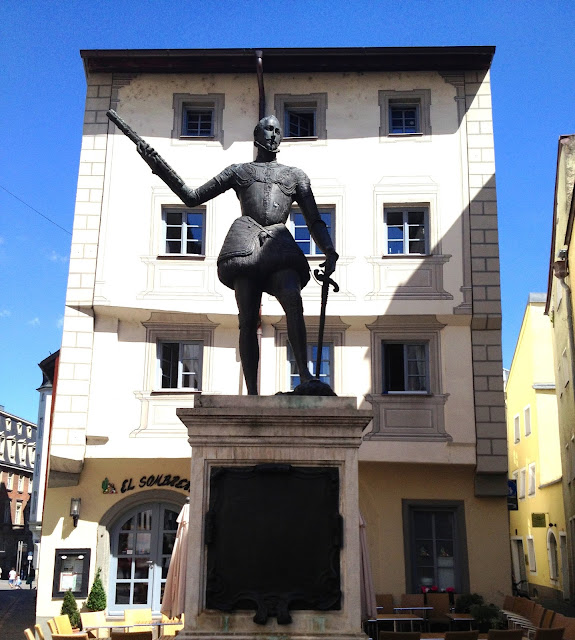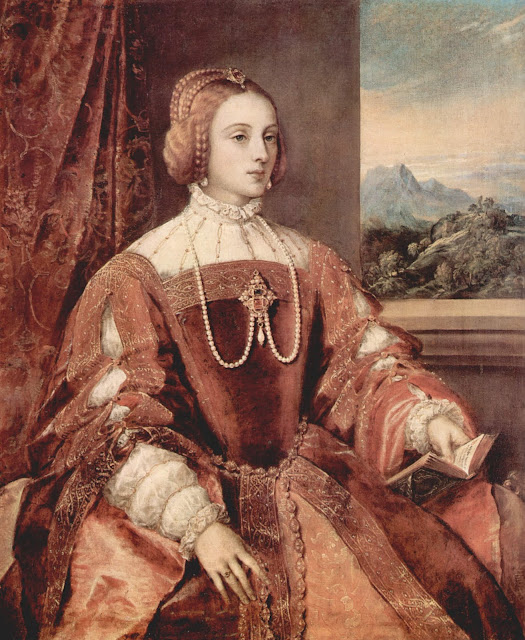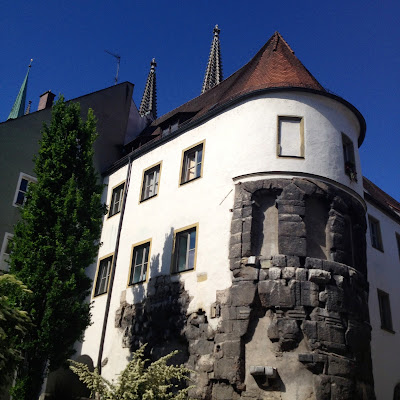 |
Bronze Bas Relief of Regensburg showing the Medieval Walls
surrounding the City, as the Danube flows outside them |
As I got deeper into the writing of this piece, it became all too apparent, that this particular day in Viking River’s Romantic Danube itinerary needed to be split in two. It simply could not be covered in any detail without asking my readers to read the longest post ever in Chewing the Fat History.
The day divided easily. The morning was spent in Regensburg, Bavaria’s second largest city, and the afternoon was spent on an excursion to Weltenburg Monastery from the town of Kelheim, where the Danube and Altmühl Rivers meet. Here’s Part 1: Regensburg. Part 2: Weltenburg Monastery will follow tomorrow.
 |
Regensburg captured in
on single photography |
I was highly familiar with the name Regensburg because we are reminded of it every time Andrew and I step into our car. Regensburg is the home of BMW and it’s the only place in the world where our model is produced. Regensburg’s claims to fame in modern Germany is not only as BMW headquarters but also those of industrial giant, Sieman’s and the German headquarters of none other than Amazon.
While we made our way through Regensburg, one image captured the city perfectly. While outside City Hall, a BMW Z series pulled up. Out came a couple to be married at the City Registry wearing traditional Bavarian dress for their wedding, driving a car made only in Regensburg.
But that’s just one side of Regensburg. The other is fascinating both visually and historically. Regensburg has the largest collection of Medieval buildings anywhere in the world. There are 1300 of them, many of them built on top of Roman ruins. It’s an absolutely extraordinary collection made even more so by the fact that this city of 150,000 people live and work in these buildings to this very day. On the left you can see a medieval tower built atop the walls of the old Roman legion outpost.
 |
| Note the Footwear. |
Some other Regensburg firsts? This is the home of a former Cardinal named Joseph Ratzinger. You may remember him better as Pope Benedict XVI, the red Prada shoe-wearing Pope and the first one to resign his office since Gregory XII did in 1415.
 |
Did a friend really ask me for
a photo of a statue of Don Juan
seen here as portrayed by Johnny Depp? |
There are endless stories about Regensburg but none with quite the allure of this one. While I was onboard the Tor, I received an email from a very dear old friend. She asked me if I could take a picture of the statue of Don Juan. I could not imagine what connection Don Juan, a fictional Spanish character, would have to this German city. But I dutifully noted my friend’s request.
 |
The Hotel where the trysts took place is the turreted
building on the left. |
You can hardly imagine my surprise as I stood listening to our Viking Tour Guide tell the following tale: Charles V, the Holy Roman Emperor and King of Germany, Italy, Spain, Sardinia and Sicily, and Naples, Lord of the Netherlands and Duke of Burgundy, came to town. In their efforts to entertain the sovereign, a local beauty and singer, was pressed into service, spending several days with the Emperor. Lo and behold, a child came out of their meeting. The local burgher’s daughter was quickly married off to a court functionary. But before he turned three, his birth father sent for the child. He was taken from his mother to become Don Juan of Austria.
 |
| Don Juan of Austria |
 |
| And his mother…none other than Barbara Blomberg! |
His statue located, I still could not figure out why my friend wanted with this photograph. Reading the plaque under the imposing figure of Don Juan, I spied a familiar name. His mother, the beauty and singer, was named Barbara Blomberg. I pause here for all the friends of Ms. Blomberg who were as startled by this discovery as I was.
Note Ms. Blomberg’s name in the third
line of the plaque commemorating her son.
I haven’t shared much food talk since my Paprika search in Budapest. I am saving all my major food articles for my sponsor on this trip, The Daily Meal. But I can hardly avoid telling you that Regensburg is home to the oldest restaurant in Germany, the aptly named “Alte Wurstkuchl”.
 |
| The Kitchen looks to be original as well. |
The name translates to “Old Sausage Kitchen”. I have no idea when the word “Alte” (Old) was added to the name but when you’ve been in business for 800 years, that could have been a very long time ago indeed. The restaurant was built in the 12th century to feed the workers building the town’s stone bridge across the Danube.
“Alte Wurstkuchl” specializes in, what else, wurst. The only menu decision to be made is whether to order 6, 8, 10 or 12 bratwursts. (In a momentary loss of memory, I could not remember ‘sex’ which is six, but had no trouble remembering ‘acht’, eight). Served with a stein of local beer, sauerkraut and sweet mustard that would make cardboard taste good, they allowed me to skip today’s lunch on the Tor. The bratwurst was so tender and delicious, I probably should have ordered zehn or zwölf.
The Longest Day, Part Two: Weltenburg Monastery will appear tomorrow.

















